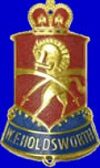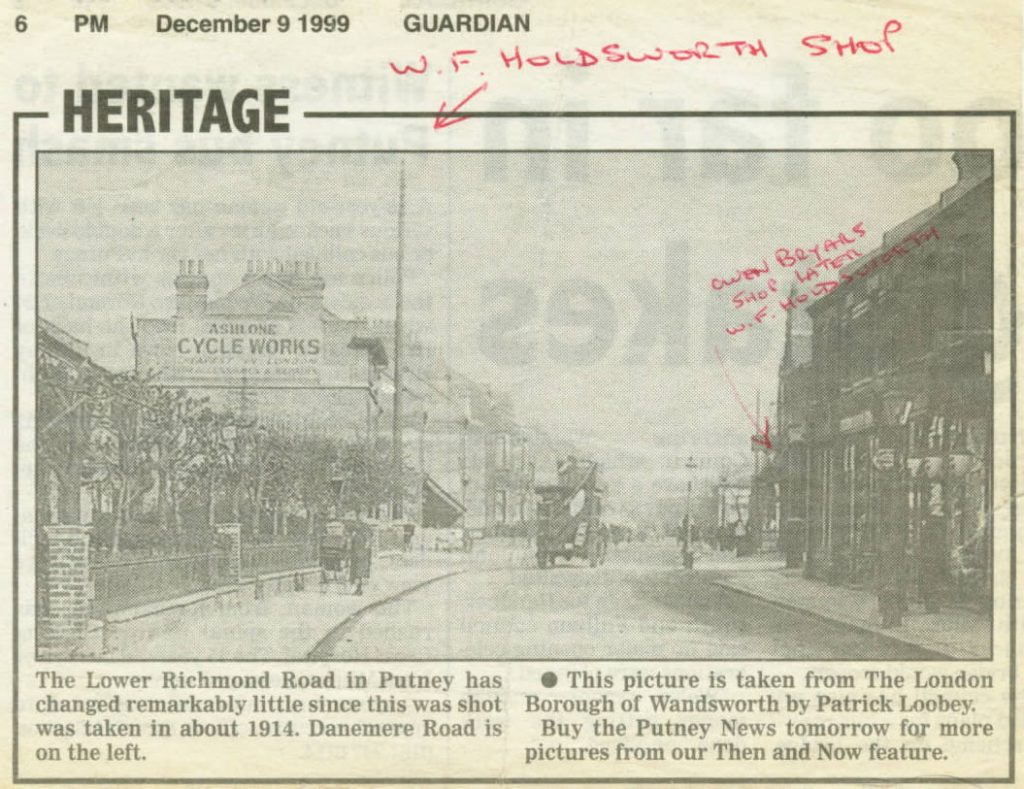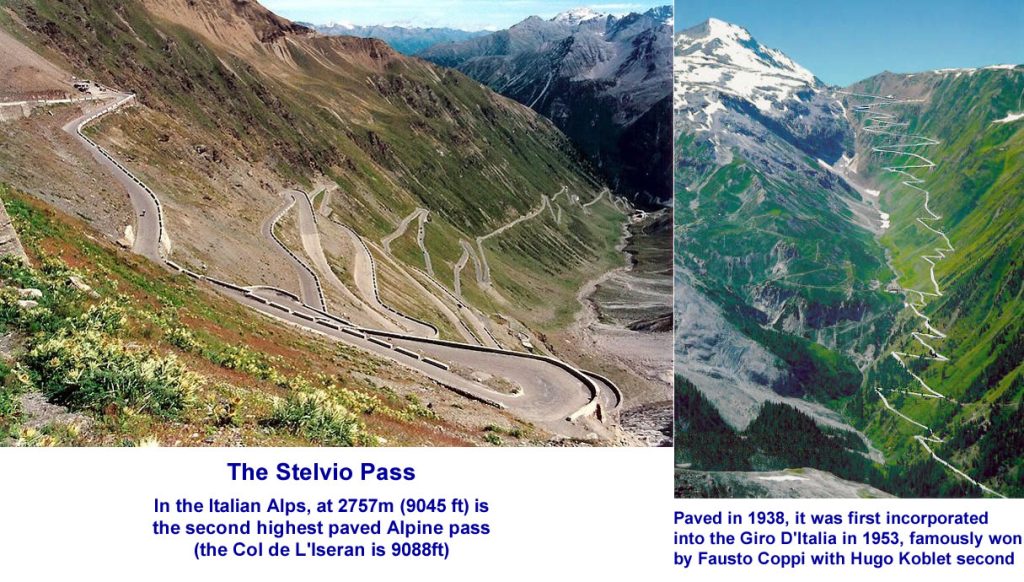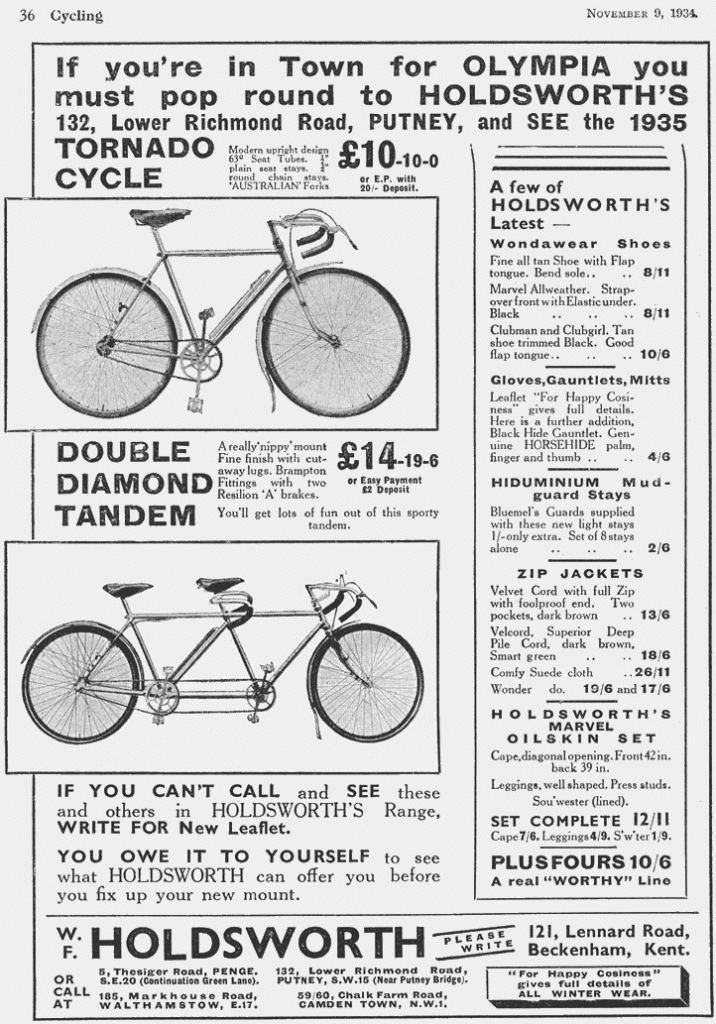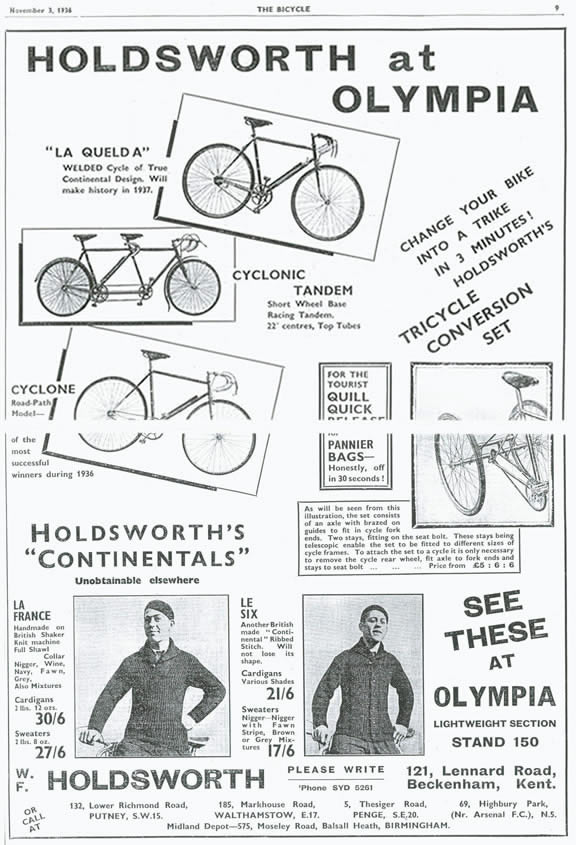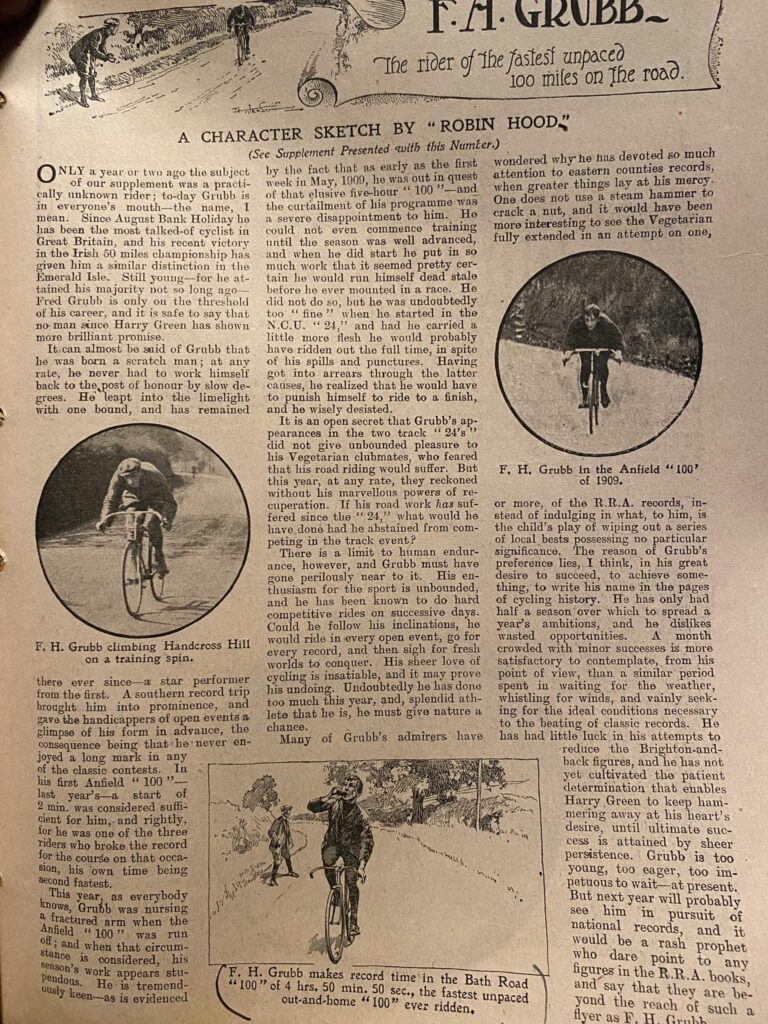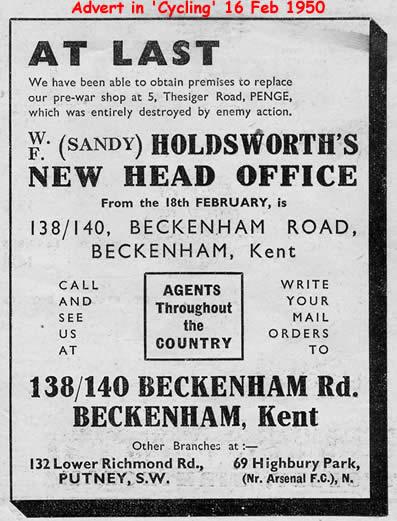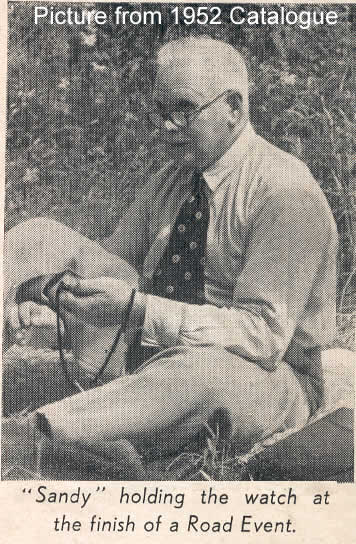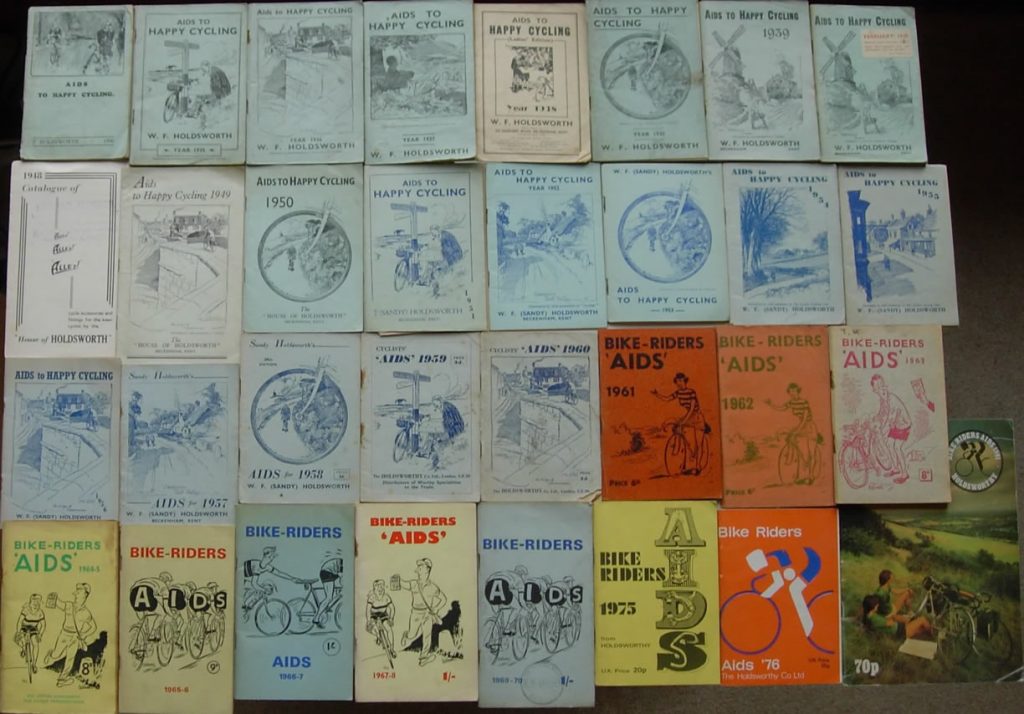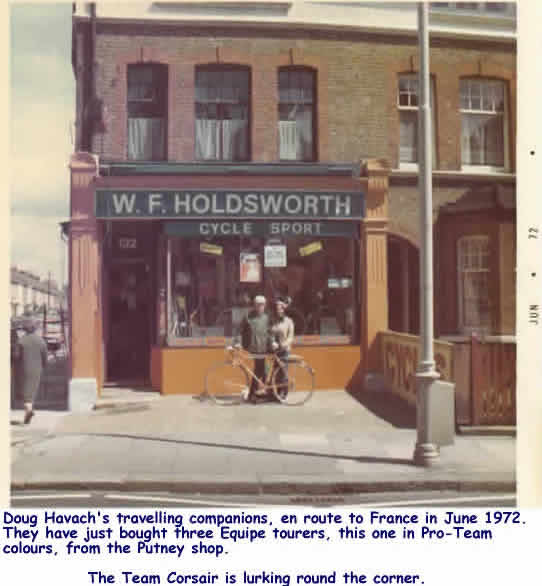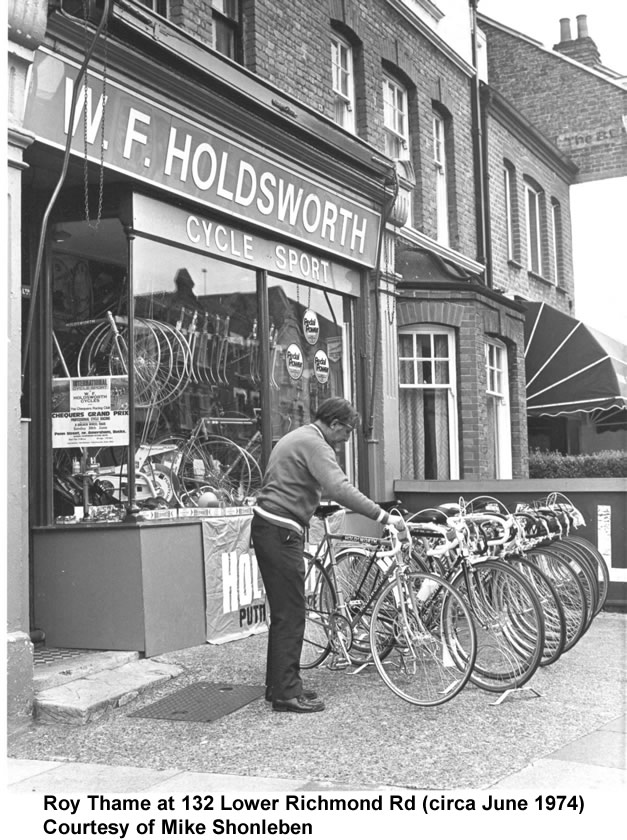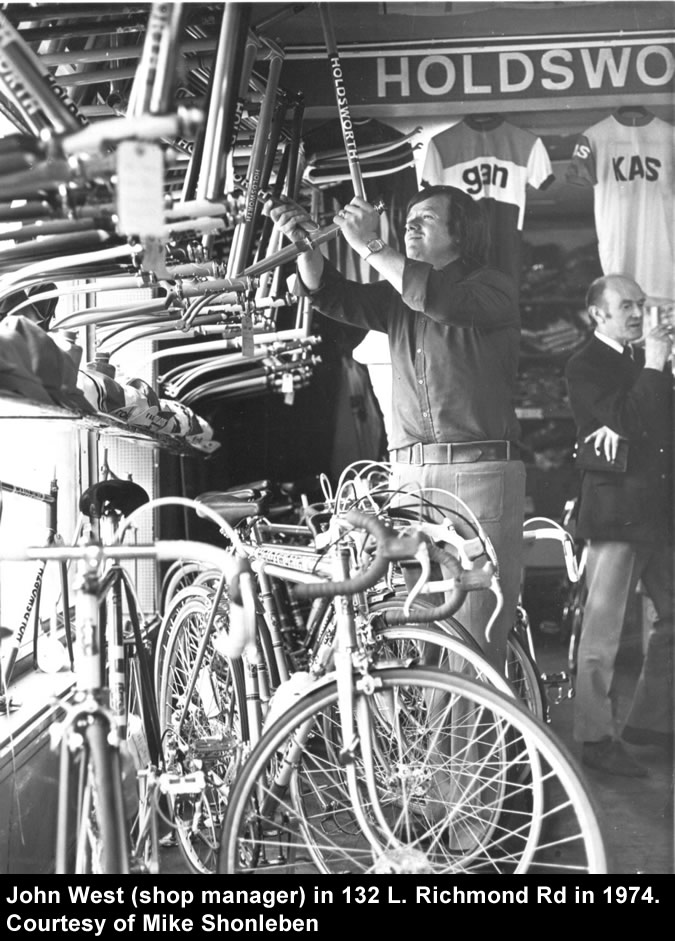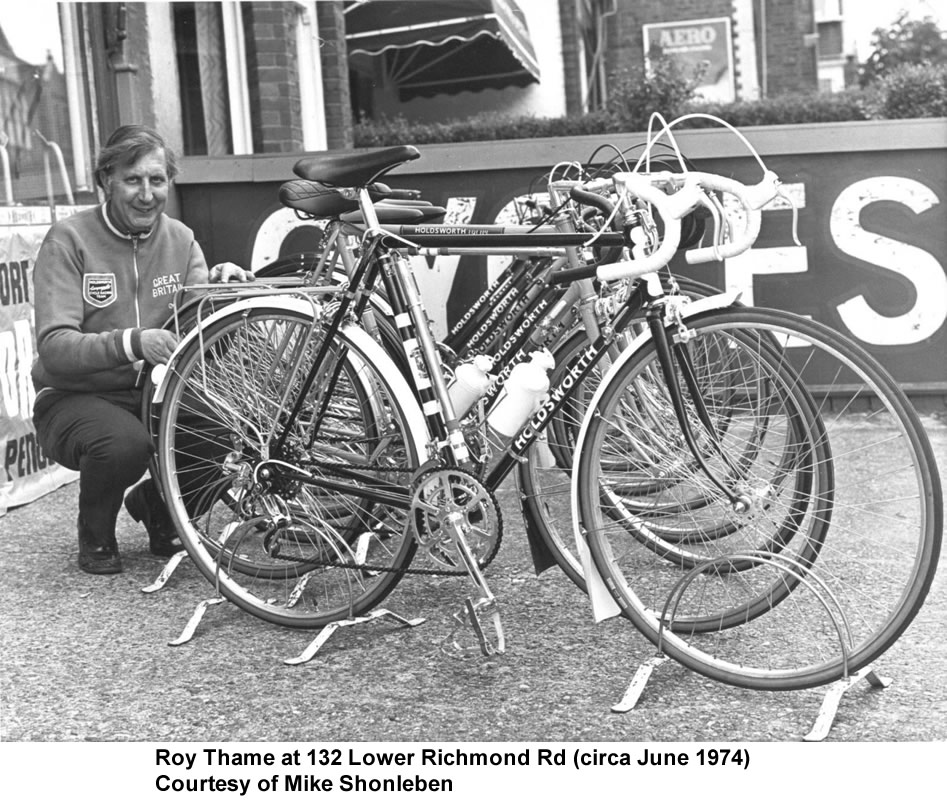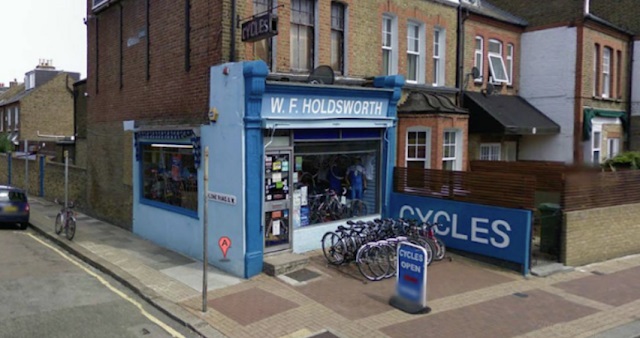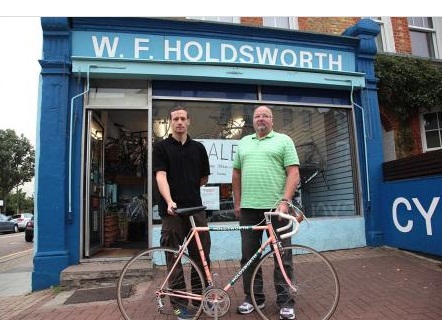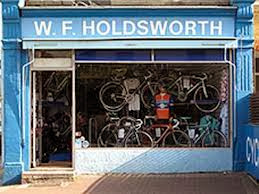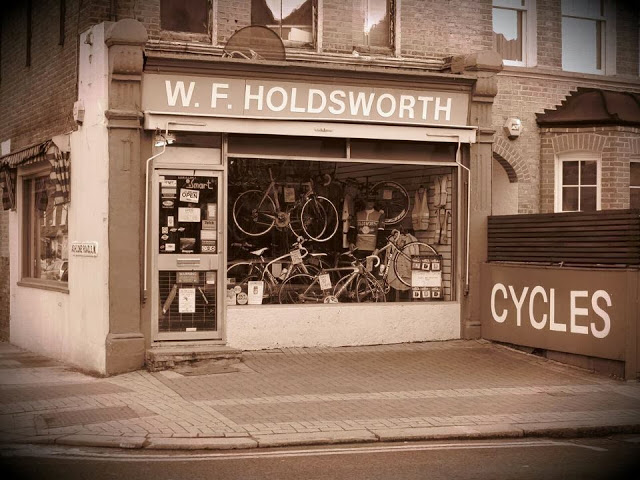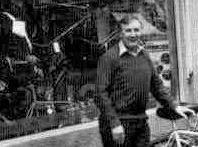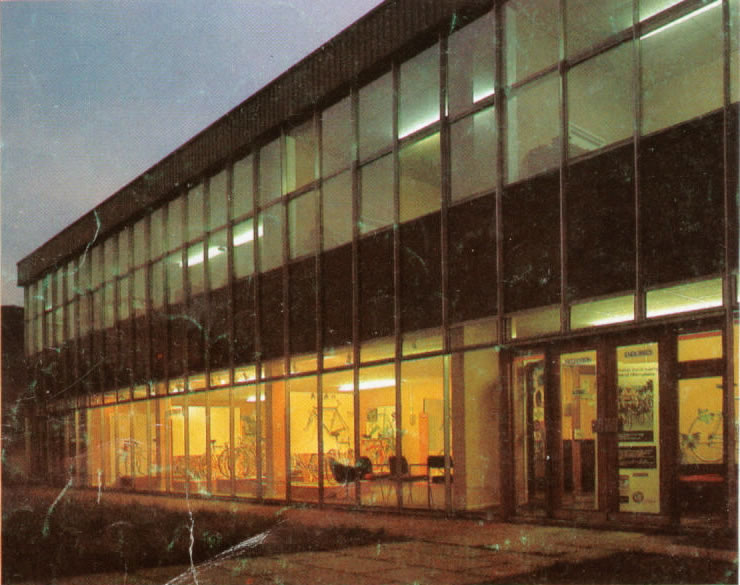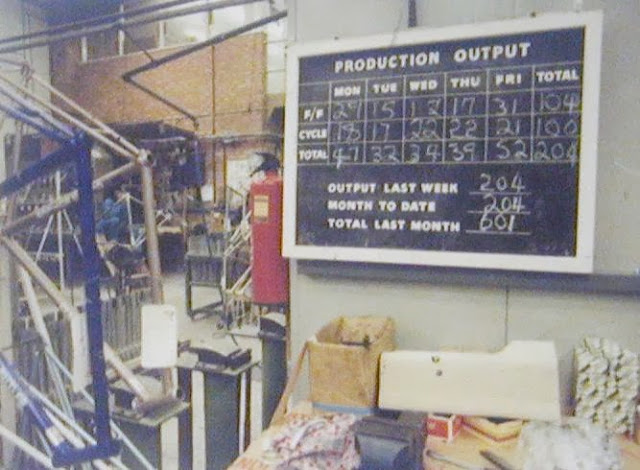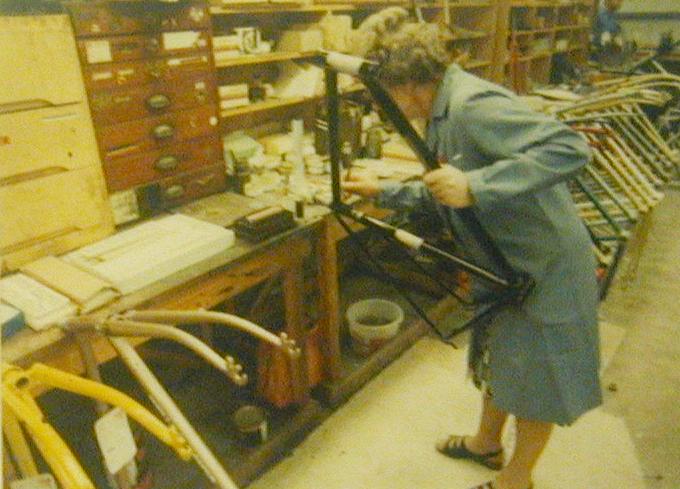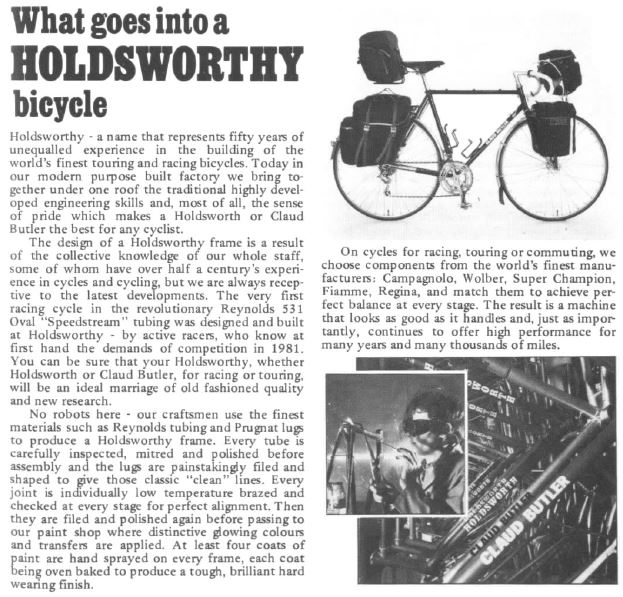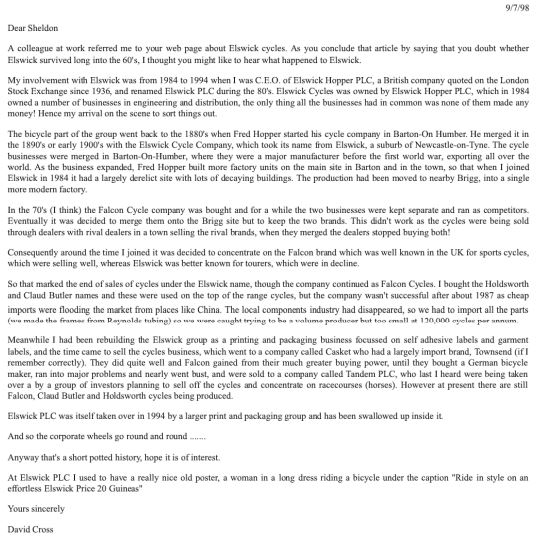W.F. Holdsworth: Company History
With particular thanks to the late Roy Thame and Bill Hurlow
William Frank (Sandy) Holdsworth (b Apr-Jun 1891)
A keen cyclist and member of the Kentish Wheelers CC. Sandy and his brother Jack set a 24 hr track tandem record which probably still stands.
Sandy worked for Legal & General Insurance until he retired (Roy Thame).
Margaret Amelia Bryars (b Jul-Sept 1900)
A keen CTC rider whose family were in the clothing textile business. Margaret (aged 15) was appointed as a Post-Office “Learner” on 25 April 1916, during WW1. Bill Hurlow told me that she was awarded an OBE because she continued serving customers while a Zeppelin was above, but I have been unable to confirm this as yet. Research Notes
After the 1914-18 war, appropriate clothing for cycling was unavailable. By early 1922 (cf 1952 ‘Aids’ Intro) Margaret had started producing shorts, plus fours, cycling skirts etc. which proved popular. Sandy and Margaret married in the first quarter of 1923. She started a mail order business late in 1923 for the 1924 season, from home at 121 Lennard Rd, Beckenham, Kent. The range grew year on year, e.g. the CTC saddlebag was added in 1926 and racing shoes in 1929. A free product catalogue “Aids to Happy Cycling” was issued, but perhaps not immediately. This ran to the calendar year, the earliest one I have is 1930.
In 1927 Sandy took over the shop at 132 Lower Richmond Rd, Putney, London SW15, from the Ashlone Cycle Works (prop. Mr Smith) who had been there since at least 1912. Mrs H’s brother Joseph OwenBryars (b 1902) was installed as manager and Jack Capeling (kept on from Ashlone) as mechanic (Sandy always referred to him as ‘my fixtures and fittings’).
Jack made the first three Holdsworth frames here, numbered 01,02, 03, the year is uncertain, but 1930-1933. “Jack used coal-gas and air (by pumping large foot bellows), a method he continued for repairs until well after WW2. Frame production continued until 1935, in the sheds at the rear of 132, under the control of Arthur Eaves, later to become Holdsworth Co. Works Manager” (RT).
The 1930’s
Aids to Happy Cycling 1930 shows Holdsworth offering a very small selection of tyres, brakes & pedals along with their mainstay of clothing, saddlebags & camping kit. This booklet and adverts to Apr 1931 all mention 4 locations.
- 121 Lennard Rd, Beckenham, Kent. (The house, write or phone only)
- 132 Lower Richmond Rd, Putney, London SW15 (Near Putney Bridge)
- 185 Markhouse Rd, Walthamstow E 17
- 5 Thesiger Rd, Penge SE20
At some stage (Jun 1932-1934) cycling garments and shoes started being marketed under the brand name “Worthy“.
On 24 Nov 1933 they advertised a complete show of Holdsworth Cycles for Olympia Week, from £7-17-6 with the Stelvio at £10-10-0 & Tandems from £16-16-0. Two new addresses have been added to the above 4:
- 59-60 Chalk Farm Road, Camden Town
- Holdsworths Provincial Depot, 143 Newtown Row, Birmingham
The 1933/4 catalogue, which was prepared & on offer by 24 Nov 1933, consisted of a range of cycles, including two tandems. This suggests they were not new to making framesets.
All bicycles were named after winds except the Stelvio “Tested in the Alps“. The Stelvio Pass is the second highest road in Europe. The Mistral was also “Tested and found very Satisfactory on a 500-mile Alpine Tour“.
Holdsworth would supply framesets alone, but only on request. In those days folk tended to buy a complete bike. They sold outsourced stems and 10 standard handlebar designs, “Any Type of Bend made in 14 days”.
Holdsworth did not exhibit at the Olympia Show at Earl’s Court 5-10 Nov 1934, however in Cycling 9 Nov 1934 they advertise the Tornado and Double Diamond Tandem for 1935 and these addresses
- 121 Lennard Rd, Beckenham, Kent. (The house, write only)
- 132 Lower Richmond Rd, Putney, London SW15
- 185 Markhouse Rd, Walthamstow E 17
- 5 Thesiger Rd, Penge SE20
- 59-60 Chalk Farm Road, Camden Town
Quill Lane 1935
In 1935 production was transferred to Quill Lane, Putney, a little over a mile from ‘132 Putney’. Bill Rann had just left FH Grubb (in liquidation) and joined as foreman. ‘Bill had been an engineer with the railway. Then at FH Grubb Twickenham he had been foreman over 50-100 staff, he was a good foreman, a quiet man but firm’ (Bill Hurlow). Bill Rann designed the Tricycle Conversion Set pre March 1936. Initially racers wouldn’t use it because it increased the wheelbase, so Bill redesigned it in a way that shortened the wheelbase. In 1936 he also designed “La Quelda” 1936 La Quelda Ad (Cycling UK). Club cyclists viewed Holdsworth primarily as a clothing company and tended to underrate the frames. Out the back of 132 Putney two wheelbuilders produced for Quill Lane and for others, Jack Capeling was always one builder, but the other changed, one was called Margetson.
The 1936 ‘Aids to Happy Cycling’, which went to press Nov-Dec 1935 gives these addresses:
The 1936 ‘Aids to Happy Cycling’, which went to press Nov-Dec 1935 gives these addresses:
- 121 Lennard Rd, Beckenham, Kent. (The house, post orders)
- 132 Lower Richmond Rd, Putney, London SW15 (Nr Putney Bridge) Mr J.O.Bryars
- 185 Markhouse Rd, Walthamstow E 17 (off Lea Bridge Rd) Mr L. Hinde
- 5 Thesiger Rd, Penge SE20 (off Green Lane) Mr S.W.Brewer
- 575 Moseley Rd, Birmingham (Midland Depot) Mr R.A.W. Prestidge
Quill Lane is not mentioned, probably to discourage callers, but the ‘Quill carrier’ which was named after Quill Lane is offered, so we know they had already opened there.
Tim Bryars says: “Owen had three daughters and one son (my father). His youngest daughter, Peggy, died c1936 aged 6, knocked down by a careless lorry driver, who was watching cricket on Barnes Common, just a few hundred yards from the shop. I’m told that the life went out of Owen when that happened”. Bill Hurlow was also hit by a truck outside the shop 1936-37, he says “I remember at the time all the talk was about the abdication of the King (that was on 11 Dec1936), but after the truck hit me I didn’t remember anything”.
Aids 1937 (printed late 1936) mentions Mr F Thacker now managing the Markhouse Rd, Walthamstow shop. A new shop at 69 Highbury Park, Highbury N5 (Near Arsenal F.C.) has appeared, managed by D.E.S. Kirby. Repairs are to be sent to the 132 Putney workshop.
Aids to Happy Cycling 1938 (printed late 1937) gives addresses:
- 121 Lennard Rd, Beckenham, Kent. (The house, post orders)
- 132 Lower Richmond Rd, Putney, London SW15 (Nr Putney Bridge) Mr J.O.Bryars
- 185 Markhouse Rd, Walthamstow E 17 (off Lea Bridge Rd) Mr Jimmy Eve (Closed during 1938)
- 69 Highbury Park Rd, Mr D.E.S. Kirby
- 575 Moseley Rd, Birmingham (Midland Depot) Mr I Furnival
- 2 Lullington Rd, Anerly SE20 (Workshops, a Putney workshop is also mentioned)
1938 Bill Hurlow (b May 1921), an ex. FHG employee (Grubb’s), joined Holdsworth at Quill Lane for a very short time, leaving to join Dee Cycles later that year. Mrs H still handled the garment side of the business from home, assisted by her employee and friend Janet Mantle (14)(later Sisley). “Sandy and Margaret were very straight-laced, they disliked bad language and drink, but nothing was too good for those they took to” (BH).
Quill Lane Fire 1938
Quill Lane had a self-employed enameller, Wally Ridgers. New models were launched at shows. Suppliers often provided special show materials, wheels, wood sprints, celluloid guards, Dunlop show tyres with gold lettering etc. A lot of show kit had been supplied to Quill Lane, for a forthcoming show, it was all stored upstairs, above Wallys oven. It is thought Wally forgot to turn something off. Owen Bryars came flying down the road on his bike, spotting Dick Clements (a packer working for Owen at 132) he called “Fire at Quill Lane”, but it was too late. (BH)
1939 The catalogue and ‘Aids’ 1939 (last for 10 yrs) give the addresses:
- 121 Lennard Rd, Beckenham, Kent.
- 132 Lower Richmond Rd, Putney, London SW15. Mr J Owen Bryars
- 69 Highbury Park, Highbury, N5. Mr D.E.S. Kirby
- 575 Moseley Rd, Balsall Heath, Birmingham 12. Mr I Furnivall
- 2 Lullington Rd, Anerly SE20 (Workshops, NO Putney workshop mentioned)
And Agents throughout the Kingdom.
Between Nov 1938 or Mar 1939 there was a difference of opinion over policy, Owen Bryars left and opened a cycle shop opposite at 153 Lower Richmond Rd. I think John de Fritaes who owned Dee Cycles took care of 132, with his new employee Bill Hurlow, until Ted Hulme arrived as manager. One day Bill told John that he didn’t see his future in retail, soon after that John told him to report to Quill Lane, he was back with Holdsworth.
The birth of Holdsworthy in 1939
The business needed to expand and finance was forthcoming from another of Mrs Holdsworth’s brothers, Austin Bryars, whose main business was in clothing and textiles. Just before WW2 a new separate company was formed, The Holdsworthy Factoring Company Ltd, with directors W.F. Holdsworth, MA Holdsworth and Austin Bryars.
Janet Mantle‘s family helped get the new factory, the ex-banana works at Lullington Rd. (separate works and warehouse, both on Lullington Rd). W.F. Holdsworth cycles and frames were produced here, they also supplied British and imported cycle equipment. Worthy clothing was supplied throughout the country and this continued all through the war on a restricted basis, although ‘Aids To Happy Cycling’ 1939 was the last issue of this little catalogue for 10 years. Frank Sisley joined Holdsworth soon after the move to Lullington, where Pete Cobb was the foreman (Bill Rann had already left, I think he returned to Grubbs).
World War 2 (3 Sept 1939- 2 Sept 1945)
Petrol rationing, which was good for bike sales, started on 22 Sep 1939. However, Reynolds were instructed to cease cycle tube production, which was not good for bike sales. One by one, Holdsworth staff were called to other duties. Frames were made, but in reducing numbers to maybe 2 or 3 a week. Bill Hurlow left c Sep 1940 to join Claud Butler, Holdsworth had almost no framebuilders left, but he returned after a couple of months. Sandy told him “don’t make a habit of it”. Frank Sisley joined the Army, he and Janet Mantle married during the war. Arthur Eaves went to Purdey guns.
The second last framebuilder was called-up late in 1941, then Bill joined the Army on 5 Feb 1942, he married later that year. Bill was an Army armourer, and found the resources to hand-make stems for the shops to sell. Staff and steel shortages meant there would be no more significant frame production until war ended. During the blitz bombing most of the factory windows were blown, these were never replaced.
The Putney and Beckenham shops stayed open, Ted Hulme and his wife had moved north. Stan Butcher was installed as caretaker manager of 132 until the Hulmes returned after the war. “Stan was a 24 hour rider, he worked in the trade and had theatrical connections. He got a half day on a Thursday, when he would go to see Mrs H to see if she had any stock he could sell in the shop. He worked very hard, he drove an ambulance after work and attended a dance hall bombing where hundreds were killed” (BH)
Mrs H was from the ‘rag trade’ where it was normal to refer to people below managerial level by their surname. Janet and the girls were called by their forename. Apart from Bill, all the men were addressed by surname only. Stan arrived on a stock foray, Mrs H was searching for stuff to give him. Suddenly she called out “do you have any balls Butcher?”, Stan went a bit red, with Bill and others prompting him to reply, but Mrs H was oblivious. (BH)
Holdsworth’s shop at 5 Thesiger Rd, Penge was destroyed by bombing during WW2.
WW II ends 2 Sep 1945
After the war people were demobbed in batches, it took 6 months for some of the younger ones to be released. Charlie Roberts returned in spring or summer 1946. In June 1946 Bill Hurlow was considering his options and visited Holdsworth where production was well under way, he returned to Holdsworth in Oct 1946.
- Arthur Eaves (foreman)
- Pete Cobbs (framebuilder, ex foreman)
- Bill Hurlow (framebuilder)
- Charlie Roberts Snr (learning)
- Sid Bishop (learning)
- 1 lug cutter
- 2 or 3 filers
Pre war and immediately post war, the one man built the whole frame. But competition from Claud Butler and Hobbs of the Barbican forced changes. Now people would do a stage of the build then pass it to the next man. They were producing 30 frames per week. I think Bill Rann returned to Holdsworth at war end and partnered Arthur Eaves.
Arthur Eaves and John de Fritaes were installed as managers, with seats on the board, of the now Holdsworthy Company Limited, which continued to expand rapidly. Before the war John had his own shop, Dee Cycles at Hearne Hill, but it had been bombed. The Hulmes returned to manage 132 Putney for a while, until Ron Dodson took over.
War had ended but rationing continued, petrol rationing lasted until 26 May 1950. This increased demand for bikes although manufacturers found it difficult to get raw materials. Until about mid 1946 Aluminium Headbadges were used.
‘Aids To Happy Cycling’ re-appeared after a 10 year lapse, with a thin 1949 issue. “All your needs are known and appreciated, but whereas pre-war we could supply everything, from a tandem-trike to a top-nut, or from shoe-plates to shorts, certain items of clothing and accessories are now either in short supply or are completely barred “By Order”. But nowhere can you get such expert service, which has been built up on the basis of quality and value over the past 25 years”.
The 1949 (and 1950) frame/bike catalogues only offer 3 models, they could not meet demand. Besides cycles and frames, they became the main import/exporters of high quality components and sold bottles, pedals, hubs, headclips, bar tape etc own branded “Allez!“.
“The hand on the torch matters more than the name on the frame”
Bill says 1946-1950 were the good years. “At FHG and Claud Butler builders were paid a flat rate. Holdsworth paid piece rate, a fixed sum depending on the model, for each frame made. We had much better equipment than Grubb’s or CB and you knew the frame would be quality tested using the same tools you used. You signed your frame sheet, if it failed it’s inspection, or was returned within a year, you had to fix it without payment”. Bill was by now their top builder, twice as fast as some and never had a frame returned, so he earned a lot.
After a race Mr and Mrs H piled four passengers into the back seat of their car, plus a Welshman in the rear footwell. The Welshman said, and often repeated, that he “could murder a bloody pint”. Bill and others were kicking him subtly, he didn’t know Mr & Mrs H very well, but he just thought the kickers were uncomfortable and carried on regardless.
Sandy would cycle in sometimes to announce things, usually at closing time. He’d be at one end, but with people restless to get home you couldn’t hear him. Mrs H, like most of the Bryars family had a loud voice, her’s quite high. Clear as a bell you’d hear “stand by the drill dear, where they can hear you”.
After Fred Grubb died (Mar 1949), an ex Holdsworth director Ivor Cox joined Grubb’s as did Bill Rann and Charlie Roberts (for a few months).
The 1950’s
18 Feb 1950 W.F. Holdsworth opened at 138/140 Beckenham Rd, Beckenham, Kent, with Lou Smith as shop manager for many years, this was the new Head Office and mail order outlet of WF Holdsworth Ltd. Both Lou and Ron Dodson had been with the Holdsworthy Factoring Company and had been in the Kentish Wheelers (where Sandy was President). Almost all Holdsworth staff were, or had been, cyclists.
Petrol rationing ended on 26 May 1950, motorists cheered in the streets as they tore up their ration books. Bike parts became available, so to meet current demand and clear their waiting list, which had built-up during the rationing years, bike manufacturers increased production. The available fuel was low grade, but some potential bike buyers now opted for a motorbike, perhaps with a side-car or even a car. So demand for quality bikes fell. Once the waiting list was cleared, they were over-staffed facing a lowered demand. When the huge new refineries came on-stream, at Fawley, Southampton (officially opened by PM Clement Atlee on 14 Sep 1951) and in Cheshire, producing vast quantities of high grade fuel, bicycle sales fell again.
FH Grubb Ltd folded in May 1951. Holdsworth immediately bought the marque and stock, but decided to use a recently adopted form of his name on their bikes Freddie Grubb the first one was brazed up by Bill Hurlow very late in 1951 or early 1952. Bill says late 1951/ early 1952 business at Holdsworth was so slow they used to wait for the mail to be opened to see if they had frames to build. They used plain gauge tubing on Freddie Grubbs, they were aimed at the “Winter Bike” market. Bill left just after Easter 1952. Stan Butcher, the WF Holdsworth wartime shop manager, joined Holdsworthy about then.
Tubes and Construction
Reynolds HM (High Manganese) tubing was used by Holdsworth through the 1930’s. When Reynolds 531 (mang-moly steel) appeared in 1935 it soon replaced HM on most models, but the pre-war La Quelda was steel welded and HM was better for this, welded 531 proved snappy. After WW2 the La Quelda was in 531, as it was now fillet brazed. Accles & Pollock Kromo (chrome-moly steel) appeared as an option on most Holdsworths in 1952, at the exact same price as 531. In 1953 the customer could also chose between welded construction (which means fillet brazed after WW2), or brazed (lugged) at extra cost.
Accles & Pollock (History) Kromo tubes were heavily promoted in the early 1950’s, but Accles soon withdrew from the bicycle market. Reynolds tubes and lugged construction became the norm.
In March 1953 Roy Thame (1921-2006) became manager of W.F. Holdsworth’s shop in Putney (a 53 year!! association in Mar 2006). “After service in the Royal Navy, I worked for Les Hitchcock in his cycle shop in Hemel Hempstead and it was here that I met Ron Dodson, who although manager of W.F. Holdsworth Putney shop, still did some travelling for the Holdsworthy Company. Early in 1953 Ron told me he was emigrating to New Zealand and suggested that I apply for the managers job at Putney….. I was an active member of the Hemel Hempstead Cycling Club, being club time-trial champion in 1952, but on moving to Putney joined as a first claim member of the Fulham Wheelers” (RT). I am sorry to report that Roy died in 2006 after a short illness.
Holdsworthy were main wholesalers for some major brands, along with their own house brands like “ Allez!” and “il Primo“. They became the sole UK importer of Campagnolo components for 1955. For 1957, “Aids to Happy Cycling“ was renamed “Sandy Holdsworths Aids for 1957” and in 1958 it ceased to be free of charge, for 1959 and 1960 it became “Cyclists Aids” , then “Bike Riders Aids” until 1981.
Early 1956 Reg Collard joined Holdsworthy as the custom frame-builder at Lullington Rd.
“The factory operated a simple production line with about twelve builders each completing a stage of the build. The foreman was Charlie Roberts later to set up Roberts Cycles and to custom build for Roy Thame. There was no powered machinery other than a grindstone, everything was done by hand. One chap hand cut all the lugs for the most expensive models while another built forks, one brazed heads, another brazed bottom brackets, another brazed seat stays & fitted various bits e.g. gear bosses, brake eyes etc. An apprentice cut & mitred tubes to length on a hand press”.
“Frames were then sandblasted before being filed & finished ready for painting. The amount of filing was dependent on the model; the most expensive having all the lugs chamfered, around half a day’s work. Normally a dozen frames of the same model/size would be completed as a batch. The exception to this rule was custom builds where one person completed everything except lug cutting and final filing. I was the custom builder. I was paid £10-00 per week plus 7s/6d per frame. On average I could complete around eight frames a week”.
“Factory conditions were very basic most of the windows did not have any glass in them after the war. We used to have all the big brazing torches going full blast during the winter to keep warm, imagine around two feet of flame coming out of a torch, dangerous or what? In the summer it was like working in an oven!”. (RC)
“There was some sort of a bust up and several of us including Charlie Roberts left the company in 1957” (RC). Charlie Roberts (snr) was back working at Holdsworthy in the late 60’s.
In July 1956 president Nasser nationalised the Suez canal, hitting fuel supplies to UK and British industry. Claud Butler, already in financial straits, succumbed in Oct 1956. Petrol rationing was introduced in Jan 1957 and by the time it was lifted, 14 May 1957, much of British industry, including Holdsworth, was (and remained) on a 4 day week. Adam Hill’s deal to buy the Claud Butler and Saxon marques fell through. In July 1958 the Holdsworth Co Ltd, Lullington Rd, Anerly, London SE20 bought three registered Claud Butler trade marks.(Colin Matthews):
- No. 654268 ‘CB and link design Headbadge’
- No. 579689 ‘CB monogram and device’
- No. 612055 ‘Claud Butler signature’
This was a very good move. The Claud Butler brand was highly respected, sales increased dramatically. The factory now on a full working week struggled to keep pace with demand. Initially, a Holdsworth model and its CB equivalent were virtually identical.
1958: 132 Putney takes over production of all Special Builds
“The Holdsworthy Company had now progressed to the stage where they produced a set range of cycle frames and were no longer prepared to build to individual requirements. The two shops were being asked for ‘specials’ and so the Holdsworthy Company allocated them a block of frame numbers and Reg Collard, an ex Holdsworthy frame builder, was recruited and started building Holdsworth frames to order, in a small workshop on the premises of 132 Lower Richmond Rd Putney. The designs were based on the Italian Colnago frames and were of very high standard” (RT).
“When Roy Thame approached me to set up a custom build workshop at 132, I jumped at the opportunity. We had to get all the jigs etc. built by a local toolmaker. With these and cylinders of oxyacetylene and oxygen, we were in business. We already had a long list of orders. Soon after the first frame was completed we had a visit from Sandy and Mrs H. Great excitement! Orders came flooding and very soon there was around three months waiting list for a new frame. I was building mainly road frames plus track frames, which doubled up as time trial bikes, most people raced TTs. on fixed wheel until the mid sixties. We also produced a limited number of touring frames, with brazed on fittings for custom-built carriers and various other accessories”. (RC)
Roy Thame retired from competitive cycling in 1958 due to pressure of work, but was active on the administrative side. He was on two BCF committees (Finance and Management, and West London Div.). He was commissaire and took charge of the Tour of the West, was chief commissaire in the Milk Race for two years. He was team mechanic to the British teams and also became British Team Manager and BCF W. London Div. Coach. (RT).
18 Oct 1958 Owen Bryars died aged 56, his second wife Nan (nee Nancy Hentsch) continued the business at 153 Lower Richmond Rd, managed by Owens son Ron. The shop was bought by W.F. Holdsworth in 1959, and Ron continued to manage it until 1960. W.F. Holdsworth sold ‘bread and butter’ bikes and later BMX’s from there, 132 L. Richmond Rd being the lightweight bike shop.
The 1960’s
Sandy Holdsworth died on 28 Aug 1961, leaving Mrs H the sole owner of the W.F. Holdsworth shops, with Sandys share in the Holdsworthy Co. Ltd also added to her own.
For 1961 the annual accessories catalogue “Cyclists Aids” was renamed BIKE-RIDERS ‘AIDS’. It still ran to the calendar year until the 1964-65 issue, from then on it came out at Easter (copy went to the printer 2 months before) until the final issue in 1981. The ‘Aids’ booklet offered clothing and components, mainly Campagnolo but also Cinelli, Regina, Fiamme, Weinmann, Universal, SR, Clement tubulars etc. With the known exceptions of 1976 and 1981, details of cycles and framesets on offer were not in the ‘Aids’ booklet. Holdsworth kitted their bikes from the range of components they supplied, which was fairly extensive, only the top-enders would be Campagnolo throughout.
The shops split further away
Mrs Holdsworth died on 24 Jan 1964. In her Will Mrs H. left the retail part of the business (W.F. Holdsworth Ltd) to her shop managers, two thirds to Roy Thame and one third to Lou Smith, while her shares in Holdsworthy Co. Ltd stayed in the Bryars family. Thus the businesses split, almost immediately after Mrs H’s death. “We had started producing some frames prior to Mrs H’s death as the plan was to split and form a separate company, but she died before that could be instigated” (RT).
The wholesaling side, which included the factory, was called “The Holdsworthy Company Limited”. Mrs H’s shares were left to certain relatives, and these in due course were purchased by David Bryars, who had taken over the interest on the death of his father Austin, he ultimately became the sole shareholder.
The retail side was incorporated on 18 Dec 1964 as W.F. Holdsworth Ltd, registered office 132 Lower Richmond Rd, Putney, with Roy Thame as Chairman/MD, wife Alma, Lou Smith and his wife Ann (CO Sec.) as directors and shareholders. The business consisted of the leasehold of both Putney shops and 138/140 Beckenham Rd, Kent. These were on a long lease from Mrs Holdsworth’s executor (her brother-in-law Mr Welch) (RT).
The shop started its own frame numbering system in 1965. The first pro, Bob Addy, was signed by W.F.Holdsworth in 1966 and did well, Roger Newton joined him early in 1968. Holdsworthy agreed to help sponsor a larger team and other riders were signed late in 1968. The Holdsworth-Campagnolo Pro Team was ready for the 1969 season, with Roy Thame as team director. They soon became the top UK squad (see pro- team page).
MACLEAN closed on 11 Nov 1962. Holdsworthy bought the name, but perhaps later. A ‘Holdsworthy’ MacLean catalogue first appears on the rear cover of ‘AIDS’ issued Easter 1965. Dick Brodrick joined the 132 shop in 1967, he recalls they were plain gauge tubing, nearly always black, with gold lug-lining and lettering. They sold few and those were mostly to locals. MacLeans are last mentioned on the back cover of ‘Aids’ issued Easter 1975.
Charlie Bruce worked at Lullington Rd from 1967-1971, working with Frank and Janet Sisley and Alan Bridges (who joined the Holds-Campag Pro team). Bruce Biddle (1970 Commonwealth Games Road Gold) worked at Lullington too.
c1969 a warehouse fire nearly destroyed the whole business. “The factories were very old. The Frame Shop and Warehouse were an old banana warehouse that ran along the back of the houses. The smaller factory down the road was the Paint and Assembly Shop and also the Office that controlled the orders. The whole area was later redeveloped and Lullington road does not exist as it was in those days”. (Charlie Bruce)
The 1970’s
The ‘132’ Putney shop (managed by John West) now produced it’s own range, but sold factory bikes too. Alma and Roy’s nephew, Mike Shonleben joined here in 1971. 153/153a was managed by Pete Wickins. “The business was progressing very well & the freehold of 132 L.Richmond Rd was purchased” (RT). The Beckenham shop lease was then sold 1970-72, so it moved to 190 High St. Penge SE 20.
In 1973 these were their three shops in the London area. Soon there were five shops, the business of Alec Bird Cycles at 69 High St, Welling, Kent was purchased and became W.F. Holdsworth, also the Ken Ryall shop in Stains Rd, Hounslow, Middlesex. Ken Ryall was the sole importer of Raxar clothing which made a good addition to the various other goods imported by W.F. Holdsworth. About 1975 the Penge shop moved again, this time to 55 High Street, Penge. where they traded for c10 years.
These pics can be dated by content to April-July 1974
In the 1960’s and 70’s a large number of Holdsworths were sold in the USA (a bike boom started c1972). Hill Cycles, Germantown Avenue, Philadelphia, imported Holdsworths directly and sold them either as Holdsworths or privately labelled, the shop closed, probably in 1993.
Roberts Cycles of Chicago also supplied Holdsworths (and Campagnolo equipment)

“One thing I remember clearly is the huge number of bikes and accessories we were exporting to a then little known company in the USA called Specialised” (Jim Hagan of Holdsworthy 1970-c73 and late 74/75- early 78). In the late 70’s-early 80’s Bike Warehouse (later called Bike Nashbar) are thought to have sold Holdsworth frames through their catalogue, also Colnago.

In Canada, Holdsworth was the frame of choice for ex-pats, they were sold exclusively by Bloor Cycle in Toronto, but the store over-expanded in the 80’s and went down. From then on the frames were available in Canada by mail order only (e.g. via Freewheel of London).
The factory supplied unbranded frames to smaller companies for ‘own-branding’. Charlie Davey, for example, put his name on some top end Holdsworths. In the early 70’s a batch of mistrals were seen being badged as Gillotts in Penge, Gillott having been taken over by Edwardes in the early 60’s. One known Gillott ‘Mistral’ has either a special Holdsworth or a Gillott serial number. Total production of Holdsworths around 1972 was c1500 cycles/year, rising around 1980 to nearer 7000/year (including Clauds in latter number), with fewer models offered.
1975 The Shop stops making ‘Holdsworth’ frames
The ‘brand’ matter had been simmering for a while within Holdsworthy, where David Goodall had been appointed MD. In 1975 David Bryars (who had recently become Chairman of Holdsworthy) withdrew permission for the shop to build ‘Holdsworth’ frames. The shop revived the old ‘W.F. Holdsworth’ decal and used it on some frames, unfortunately these had to be stopped too, so they adopted the Roy Thame marque (The Road to Fame is on a Roy Thame).
“For the 1975 Harrogate Show we introduced the ‘Campionissimo’ range, these replace the Strada, etc. They were a great range of frames and caused a great stir at the show. Viscount Lindley opened the Harrogate Show, he was a keen cyclist and a good customer of ours, he rode our bikes until he took up motorcycling. I used to go to Beadles School where he was studying and coach a group of young students” (RT).
Harrogate Cycle Show (1975) Holdsworthy and W.F. Holdsworth had separate stands.
W.F. Holdsworth: (the shops) showed Roy Thame frames, some with Campag vertical dropouts. The dearest machine in the whole show was the copper-finish Campionissimo at £475 (frame £85), Italia ‘Super Tourissimo’ 10sp, with Campag Rally gear and stainless steel guards, for £210, Competizione touring model at £115, with Suntour 10sp and alloy guards. (Shop production dropped away after the main frame builder moved on. The last Roy Thame was made c1995).
Holdsworthy: Professional super record model at £356 (frame £71), the Autograph series of frames and cycles at lower price, with Freddie Grubb and Claud Butler least expensive of all. The dearest frame was the Alan alloy (£125 with Campag fittings) (Cyclotouring Aug/Sept 1975).
More Shop Photos
Later Pictures of the shop. Note block paving, new door & windows and canopy below shop name
Factory-only Holdsworths
Sometime after May 1975, Holdsworthy moved from Lullington Rd to a new factory/warehouse:
The Holdsworthy Company Limited
1 Oakfield Road, (off High St, Penge)
Anerley, London SE20 8DE
In the mid 1970’s Bill Hurlow was a consultant to Holdsworthy on framebuilding matters, this continued until at least 1979, but it reduced to 1 day per week. The Freddie Grubb marque appears to have been dropped in 1978.
Lou Smith died in a road cycling accident c1980, his wife Ann took over his shares in W.F. Holdsworth, she was assisted by her son in law Bob Donnington, who managed the Penge shop. Ann was moving back to the Manchester area, so Roy bought her shares making Roy and Alma the only shareholders.
The warehouse and workshop remained at Oakfield Rd, until after the sale to Marlboro. Upstairs was the “model shop” for prototypes and special builds. Simon Pipe was a brazer, painter & finisher here in the early 1980s and his letter in Cycling Utah, May 1999 paints a vivid picture.
1986 – THE “MARLBORO” HOLDSWORTH
By Easter 1985 there was a Marlboro presence at Holdsworthy and about Nov 1985 they took over. Holdsworth (and CB) production soon moved from Anerly to the The Holdsworthy Co Ltd, Alma Works, Darlaston Road, Darlaston (now Wednesbury), West Midlands (now industrial/commercial units). The 1986 range had more lower end models, as the budget “Challenger” range was added, but the top models maintain their high quality.
In 1986 Roy Thame was hospitalised for a month and decided it was time to ease off. The Welling business was sold to the manager Peter Elliot, the Penge business was sold to the manager Bob Donnington. The Hounslow shop was closed. Mike Shonleben was appointed a Director and took over the management of 132 L Richmond Rd. The shop at 153/153a was sold (not as a cycle shop) and Mike took over the complete running of the business, with a one third share. The lightweight side was gradually phased out.
Falcon Take-Over
In Feb.1987 Falcon Cycles Ltd, who themselves were part of the Elswick Hopper group since 1978, bought Holdsworth for £950,000. Holdsworth and Claud Butler frames moved into volume production on Falcon’s Brigg site. The Holdsworth and Claud Butler brands were reserved for the higher quality cycles (£400+!). They were producing around 120,000 cycles per annum (including Falcons) but this was insufficient. See David Cross’ letter (Scroll to the bottom of Sheldon’s page) for a beautifully written insight
Casket PLC then stepped in, they already had a largely import brand (Townsend). Initially it was a distributor but grew by acquisition to be a major manufacturer. In Feb 1990 the subsidiary Townsend Cycle Ltd, paid £182,500 for the British Eagle Cycle Company , who had fallen into receivership Dec 1989, gaining the ‘British Eagle’ and ‘Coventry Eagle’ brand names.
In DEC 1991 Casket (Townsend) bought the bicycle part of the Elswick business for £900,000, acquiring the Holdsworth, Claud Butler and Falcon names. They also had the name ‘Harrier’. The brands moved further into the mass-market.
In 1994 Townsend sold 620,000 bicycles, second in the UK to Raleigh (c800k). Falcon benefited from their greater buying power, but Casket bought a German bicycle maker, ran into serious problems, nearly went bust, and ‘merged’ with EFG (Oct/Nov 1995) to form Tandem PLC, who continued to sell Claud Butler and Falcon cycles. I’m not sure whether the Holdsworth name was retained or sold, I suspect it was sold about now.
April 1998 Holdsworth bikes were displayed on a stand at the ‘Green Transport’ show in Chester – Steve Howe wrote “Nice bikes! (if not remotely like my trusty old Holdsworth)”. Had the name been sold?
In June 1998 the Chief Executive and two directors of Tandem were ousted by a shareholders rebellion, it was decided to go into racecourses. In July 1998 Tandem put the Falcon and Townsend businesses up for sale, in Nov 1998 they closed their bicycle operations at Leigh, Manchester, but then withdrew Falcon from sale (Feb 99), after failing to agree terms with a potential buyer. In Sept 2000 Tandem Group bought the “Two wheel Trading Company” who make cycle components.
The loyal Janet Sisley died c 2000. Roy Thame passed away in 2006 aged 85.
The first W.F.Holdsworth shop, at 132 Lower Richmond Rd, Putney, London, SW15 1LN, where the original Holdsworths were sold, and some made, continued under Roy Thame’s nephew, Mike Shonleben for over 30 years, The last ‘Roy Thame’ was made in 1995 as lightweights were phased out, instead they specialised in good quality ATB’s. The closure of that shop in October 2013 was a sad milestone.
Ownership of the Holdsworth marque passed to British manufacturer Planet X of Sheffield, Barnsley & Edinburgh in 2014. They officially launched their first range of Holdsworths at L’eroica 21-22 June 2014. Many built of the famous Reynolds 531 and adopting classic Holdsworth model names… Stelvio, Cyclone, Mistral, Lady Mistral, Italia, Professional and Zephyr. The Stelvio is now full carbon and a mountain bike frame – so Stelvio is an appropriate model name. Fortunately it is not at all like the original Stelvio, which Margaret Holdsworth tested in the Alps, during the summer of 1933!
